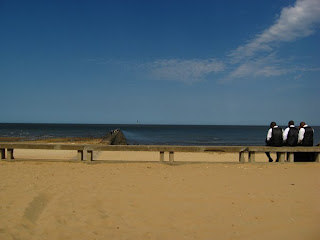I've just finished reading Martin Meredith's "The State of Africa" - an excellent summary of African history since the 1950s - and very dismal reading: a litany of the abuse of power of dictators, generals and politicians, their extraordinary greed (Kenya's Daniel arap Moi was estimated to have looted $3 billion during his 24 years in power), and their cynical exploitation of tribal loyalties to unleash violence whenever they thought it suited them. What comes across very clearly is that the disasters that hit the headlines of the western media, in which place names come to stand for extremes of human misery - Biafra, Rwanda, Darfur - are always caused by or exacerbated by factional politics. In many countries governments have purposefully eliminated entire groups of their own people rather than put up with opposition - and withholding food has often been used as a weapon and a campaign tactic (Abednico Ncube, Zimbabwe's Deputy Minister for Social Welfare, addressed a village in 2002 saying "You have to vote for Zanu-PF candidates before the government starts rethinking your entitlement to this food aid").
Meredith's conclusion doesn't offer much hope for improvement. Africa was already the world's poorest region fifty years ago, and it's only fallen further behind - average income is a third lower than the next poorest region (South Asia). Most Africans are poorer now than they were thirty years ago - half of the people in Africa life on less than one dollar a day. Africa's entire economic output is 1.3% of world GDP - less than Mexico's. Half of all African women are illiterate. Life expectancy is falling - especially because of AIDS, which was only addressed very late by most African countries - in Botswana 37% of the population is HIV-positive (and in SA Mbeki's government perversely denied any connections between HIV and AIDS - it was considered to be a plot against Africans, and AIDS was jokingly refered to as "Afrikaaner Invention to Deprive us of Sex").
Meredith concludes that Africa needs Western help and better government - but the two need to go together: Western donor fatigue has set in because $300 billion of Western aid seems to have made little difference - aid has been falling since the 1990s; the US spends .01% of its budget on aid to sub-Saharan Africa. At the same time Western governments stop many African products from competing on world markets by subsidising their own agricultural sectors - the US and the EU subsidise their cotton farmers to a value which is higher than the value of the crop itself - allowing them to take a third of the world market - the lower world price represents a cost to Burkina Faso (as an example) of 12% of its entire exports - a similar story can be told about sugar, rice, tomatoes and onions. So - the West isn't helping.
But Meredith's main conclusion is that, apart from in SA and Botswana, Africa's politicians have to take most of the blame for the state of Africa: "After decades of mismanagement and corruption, most African states have become hollowed out. They are no long instruments capable of serving the public good."
Monday, May 18, 2009
Friday, May 8, 2009
Isicathamiya and Oswenka





Last night I saw a wonderful performance by Mtuba Thulisa Brothers, an Isicathamiya group - this is the style of Zulu music and dance developed by migrant mine workers and made famous by Ladysmith Black Mambazo. It's extremely impressive and very moving done live - impeccably choreographed, and the harmonies are stunning.
There was also an Oswenka competition - this too is a tradition developed by mine workers for their Saturday night self-entertainment - they often couldn't afford or weren't allowed to go off the compound: between Isicathamiya performances individuals put on their best suits and "swanked", with audience reaction being taken into consideration by a judge when awarding the prizes. The swankers pose, take off their jackets to show off their shirts, lift their trouser legs to display matching socks, etc. - all done with much irony - to a storm of hoots, whistles and applause from the audience. Great fun.
Friday, May 1, 2009
More Art-efacts




More plunder from my travels - the first one might need some explanation, it's a hollow gourd about 18" high into which tiny drawers have been fitted - and the blob on the top is a stylised head; the base is half a coconut. Surreal. Then: a mask; a carved and painted wooden plate; and a painted wooden fish. My flat is already starting to look a bit overcrowded with "objets", but I find this sort of shopping irresistible. They're wonderful things and I'm rubbish at bargaining (the sellers always look very happy with the final price, so from their point of view I'm a patsy) - so I can tell myself I'm helping the local economies.
Subscribe to:
Comments (Atom)






